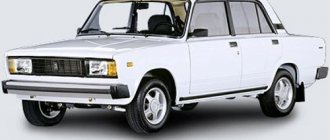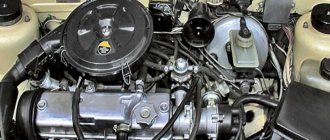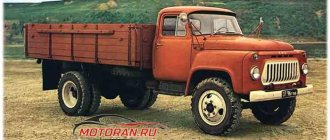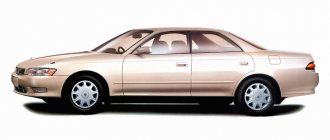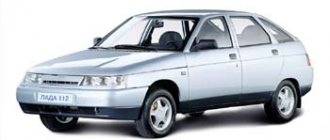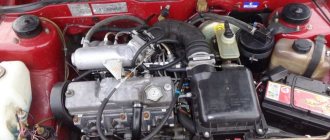VAZ 21099 is one of the most successful and popular models of the Volzhsky Automobile Plant, which went on sale in 1990 and was able to stay on the assembly line until 2011. This car, also well known under the name LADA Samara, received reliable power units that provided the necessary dynamics and excellent fuel efficiency. The VAZ 21099 engine was equipped, depending on the specific modification, with a carburetor and an injector, which made it possible to extract 73 horsepower from a volume of 1.5 liters.
Specifications
The VAZ 21099 engine has the following technical characteristics:
Download .xls file
xls
Download picture
Send by email
| OPTIONS | VALUES |
| Years of manufacture | 1990 - 2011 |
| Weight | N. d |
| Cylinder block material | cast iron |
| Motor power system | carburetor |
| Type of cylinder arrangement | In a row |
| Engine displacement | 1.5 liters |
| Engine power | 73 l. With. |
| Number of cylinders | Four |
| Number of valves | Two |
| Piston stroke | 71 millimeters |
| Cylinder diameter | 82 millimeters |
| Compression ratio | 9.8 |
| Torque Nm/rpm | 106 /360 |
| Environmental standards | EURO 2 |
| Fuel | petrol |
| Fuel consumption | 7.8/100 km |
| Oil | 5W-30 |
| Oil volume in crankcase | 3.5 liters |
| When replacing, pour | 3.2 liters |
| Oil change is carried out | every 15 thousand km |
| Motor life | |
| - according to the plant | 125 |
| - on practice | 250 |
The following models are equipped with this motor: 21083, 21093, 21099, 21111, 2115.
Modernizations [edit | edit code ]
Since 1997, at the AvtoVAZ pilot production they began to simultaneously produce the VAZ-2115 model, which was a restyled version of the VAZ-21099 and the first car of the so-called Samara-2 family. Since 1999, an option has appeared with a “Europanel” and “Eurosalon” from Samara-2.
At the end of 2004, the VAZ-21099 was discontinued by AvtoVAZ and completely replaced by the VAZ-2115 model, after which a license was purchased for the production of the model in Ukraine by ZAZ JSC. At the end of 2011, production of the VAZ-21093 (hatchback) and VAZ-21099 (sedan) was finally discontinued [6] (inaccessible link).
Description
Three power units were installed on the VAZ 21099. The four-cylinder 1.3 liter engine with a power of 64 horsepower was not in great demand among car owners, since its power was not enough for such a car.
Buyers were also offered two options for 1.5-liter gasoline engines, which differed in the intake manifold and power system.
Depending on the specific modification, it was possible to remove 73 and 79 horsepower from this engine. Note that the most popular was the carburetor engine, which had a power of 73 hp. s, was distinguished by reliability, fuel efficiency and ease of maintenance.
This modification of the power units was built on the basis of the VAZ 21083 engine. This is an eight-valve engine that used a carburetor power system and had an overhead camshaft. This power unit is made with a cast-iron cylinder block, and thanks to the installation of a carburetor power system, it is easy to operate and easy to repair.
In fact, it was a classic version of the engine, which was installed on the seventh and eighth VAZ models. This engine had a belt drive, which improved its reliability. At the same time, the service work to replace the timing belt was not particularly difficult, so every car owner could carry out such repairs. The timing belt and all rollers are replaced every fifty thousand kilometers.
This engine, provided it was timely and competently maintained, was reliable and had a service life of about 150 thousand kilometers. In practice, the mileage before major repairs could be even 250,000 kilometers.
Servicing this power unit was not difficult. The oil was changed at a mileage of 15 thousand kilometers. This unit did not require any more serious service work.
The only caveat was that it required the use of high-octane fuel. This engine was originally designed to run on 93 gasoline. But attempts to save on fuel and use 76 gasoline led to various kinds of serious damage.
The power indicator is 73 hp. s, while such power figures are achieved at a high 5600 engine rpm. It should be said that thanks to the front-wheel drive layout, the VAZ 21099 shows good dynamics with this engine and is economical. Fuel consumption in mixed mode was 7.8 liters per hundred kilometers.
Cylinder head and valves
First of all, you need to check the mating plane for warping. This is done using a obviously straight metal ruler:
If the gap in the middle part exceeds 0.1 mm, then the head must be sent to a specialized workshop for grinding or replaced. If there are cracks and deep holes - just replace!
Be sure to check the tightness of the valves by pouring kerosene into the combustion chambers and supplying compressed air through the spark plug hole:
If the valves do not hold pressure, they should be removed and inspected. To remove valve crackers, use a desiccant:
If there is damage on the valve chamfers, replace them. If there are no visible defects, grind them using a special device and lapping paste:
Achieve an even matte shine to the chamfers of the seats and valves. New valves must also be ground in!
Adjustment of the gaps is carried out by replacing the adjusting washers installed in the pushers, which can become a stumbling block for the average car owner - sometimes it is difficult to buy a washer of the required thickness. The work is carried out using a device - the pusher is pressed down and fixed with a special lever:
Malfunctions
| FAULT | CAUSES AND REMEDIES |
| The appearance of a pronounced knocking of valves when the gas pedal is sharply pressed. | The reason for this is improper operation of the carburetor, the use of low-quality low-octane gasoline, or incorrectly set valve clearances. In the latter case, the repair consists of opening the valve cover and adjusting the valves. |
| A warning signal indicating insufficient oil pressure appears on the dashboard. | The weak point of these engines was the oil filters, which often broke, causing the engine to lose oil. As a result, the insufficient pressure sensor was triggered. Repair consists of identifying the location of the leak and replacing leaky seals. |
| The motor runs with obvious interruptions. | These modifications of the power unit were equipped with Solex carburetors, which were not particularly reliable, which led to problems in the operation of the engine. The repair consisted of replacing the carburetor with an improved modification. |
| Engine cooling problems. | The cooling system used was also not reliable, which led to regular breakdowns of the pump and thermostat. To eliminate such problems, it was necessary to change the thermostat or open the engine and replace the failed cooling system pump. |
Change of oil
Engine repair 21099 begins with a maintenance operation, namely changing the oil and oil filter. This is probably the simplest operation that even novice motorists can do. Let's consider the sequence of actions aimed at changing the lubricant in the power unit:
- The oil change begins with the need to remove the negative terminal from the battery.
- Since the engine is located transversely, it is necessary to find the drain plug on the crankcase.
- We unscrew the drain plug and, replacing the container, drain the lubricant.
- When the oil is drained, tighten the drain plug, not forgetting to replace the sealing gasket.
- Unscrew the oil filter using a special puller. We install a new filter element.
- Fill in new oil. Let the power unit work a little. We measure the lubricant level using a dipstick. If necessary, top up to the level.
Tuning
This power unit allows you to increase power to 90-95 horsepower without loss of engine life. Engine tuning could be done by replacing the carburetor with a direct injection system, as well as by installing new lightweight flywheels and crankshafts. The VAZ 21099 engine with an injector produced about 90 horsepower.
There are also options for tuning the VAZ 21099 engine, which involve installing a turbine and supercharger on the power unit. It should be said that the installation of turbines made it possible to obtain a significant increase in power, but the service life of such an engine is significantly reduced. As a result, car owners had to carry out complex overhauls every 70-90 thousand kilometers.
How much can a VAZ 21099 weigh?
The total weight of the vehicle during operation is 1 ton 340 kg. The front suspension is independent with shock absorbers, coil springs, lower trailing arms with braces and longitudinal stability adjusters (McFerson). The rear suspension is on transverse correlation arms, with cylinder springs and hydraulic shock absorbers.
The front brake configuration is disc, the rear brakes are drum, with automatic clearance adjustment. Drive – hydraulic, 2-circuit, diagonal, with a vacuum booster and brake booster stabilizer. The “handbrake” is for the brake devices of the rear chassis, the drive is a cable drive.
As a result, an improved modernization of Lada of the eighth and ninth models is presented for you. With all the attendant improvements and an extended rear end. In general, the car is still used by most car enthusiasts as the most modernized brand from the entire VAZ line.
Service
Maintenance of VAZ-99 engines is carried out in the same way for both injection and carburetor versions. The service interval is 10,000 km. Every maintenance it is necessary to change the oil and filter element. As for other operations, it is worth replacing the air filter every 20-25 thousand km, as well as adjusting the valves.
Every 40,000 km it is necessary to change the gas distribution mechanism drive. In addition, after such a mileage, it is recommended to replace the spark plugs and diagnose the condition of the high-voltage wires.
It is worth checking the condition of the water pump, as well as the drive belt of auxiliary components. Particular attention is paid to the presence of leaks in the power unit. Most often they form under the valve cover - this means it's time to change the gasket.
Every 50,000 km of the VAZ-99 injection version, it is necessary to change the fuel filter and also check the condition of the injectors. As practice shows, it is during this period that they begin to clog and create discomfort for the owner. They can be cleaned and, as a last resort, replaced.

